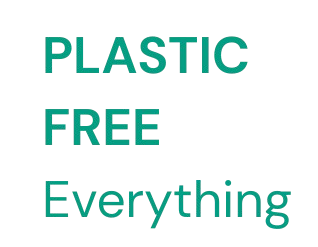Actions to Take
To help reduce your exposure to microplastics
Shop Smart: Look for Plastic Free Product Alternatives
Choose natural materials over synthetic ones.
When buying clothes, bedding, or even reusable bags, opt for cotton, hemp, bamboo, or wool. These materials don’t shed plastic fibers like polyester or nylon do, which helps reduce microfiber pollution in laundry and everyday wear.
Buy in bulk using your own containers.
Bulk food stores often let you bring your own jars or cloth bags, cutting down on single-use plastic packaging that can break down into microplastics. This also helps reduce waste at the source.
Look for Plastic-Free Versions of Everyday Products
Many plastic products have versions of them that are made from materials like aluminum, glass and silicon. When looking for products to buy, try looking for versions that are made from plastic free materials.
Avoid glitter and microbeads.
Glitter is just tiny plastic, and many exfoliating products still contain microplastic beads. Look for scrubs made with sugar, salt, or coffee grounds, and skip cosmetics with shimmer unless they use biodegradable mica.
Explore ways to reduce microplastic exposure in your water
Install a water filter that removes microplastics.
Filters with sub-micron filtration (like reverse osmosis or carbon block filters) can remove tiny plastic particles from tap water. Make this a priority if you’re drinking tap water in an area with older infrastructure.
Use glass or stainless-steel water bottles.
Reusable plastic bottles often degrade with time and repeated washing, shedding microplastics directly into your drink. Choose stainless steel or glass to avoid this issue altogether.
Avoid bottled water.
Studies show bottled water can contain double the microplastic content of tap water. Plus, the production and disposal of plastic bottles contribute significantly to environmental pollution.
Bath and Beauty Products Made with Less Plastic
Switch to bar soap and shampoo bars.
These bars often come in cardboard packaging and don’t include plastic microbeads or hidden polymers found in many liquid products. They’re also longer-lasting and travel-friendly.
Use natural exfoliants.
Look for scrubs that use ingredients like crushed walnut shells, salt, sugar, or oats. These offer the same benefits without polluting waterways with plastic particles.
Use a safety razor instead of disposables.
A stainless steel safety razor can last a lifetime and gives a better shave. It replaces the need for plastic razors, which are typically non-recyclable and end up in landfills or oceans.
Look for Plastic Free Clothing and Laundry Options
Buy fewer, better-quality clothes made from natural fibers.
Every time synthetic clothing is washed, it sheds thousands of microfibers. Choosing durable, natural materials helps reduce this shedding and supports a more sustainable fashion cycle.
Use microfiber-catching laundry tools.
Products like the Guppyfriend washing bag or the Cora Ball can capture microfibers before they enter wastewater systems, preventing them from polluting rivers and oceans.
Wash in cold water and only when needed.
Washing less frequently and using cooler temperatures helps preserve clothes and reduces fiber shedding. Use full loads and avoid long, aggressive wash cycles.
Air dry instead of tumble drying.
Dryers can break down fabrics faster and increase microfiber release. Hanging clothes to dry not only reduces plastic fiber shedding but also saves energy.
Steps you can Take in your home to Remove Microplastics
Use a vacuum with a HEPA filter.
Microplastics often settle in dust. A HEPA filter can trap tiny particles, preventing them from being recirculated into the air or inhaled by your family.
Switch to natural materials for kitchenware.
Replace plastic cutting boards, utensils, and bowls with ones made of wood, stainless steel, or glass. These materials don’t degrade into microplastics during use or dishwashing.
Use loose-leaf tea or plastic-free tea bags.
Many commercial tea bags are sealed with plastic or made of nylon mesh. Choose paper or cloth tea bags—or better yet, loose-leaf tea with a stainless steel infuser.
Avoid plastic food containers, especially when heating.
Plastics can leach microplastics and harmful chemicals when exposed to heat. Store leftovers in glass or stainless steel and never microwave plastic containers.
Level Up your Cleaning Products and Everyday Supplies
Make your own cleaners.
DIY cleaners made from vinegar, baking soda, and essential oils are effective and safe. They also eliminate the need for single-use plastic bottles filled with chemical-laden formulas.
Ditch disposable wipes.
Most cleaning and baby wipes are made from synthetic fibers that don’t biodegrade. Replace them with washable cloths or biodegradable alternatives made from bamboo or cotton.
Opt for refill stations or concentrate pods.
Many companies now offer refillable cleaning sprays and hand soaps in tablet or concentrate form. Just add water at home to reduce packaging and microplastic waste.
Be and Advocate for Change
Support plastic reduction policies.
Stay informed and vote for local, state, and national initiatives that aim to regulate microplastic pollution and reduce single-use plastics. Write to brands and legislators when needed.
Raise awareness in your community.
Talk to friends, family, and coworkers about microplastics. Share tips, host a workshop, or post on social media to help others learn and take action.
Support brands committed to plastic-free living.
Every purchase is a vote. Seek out and support companies that are transparent about their ingredients, packaging, and mission to reduce plastic use.
